I Want to Open a Page but It Redirects Me to the Same Page Over Again
We come across a lot of different errors hither at Kinsta, and ERR_TOO_MANY_REDIRECTS (as well known as a redirect loop) is one nosotros run into on a regular basis. Typically this occurs after a recent modify on your website, a misconfiguration of redirects on your server, or wrong settings with third-party services. Only don't worry, this error is fairly easy to fix.
Check out the recommendations below on how to fix this fault and get your site back upwardly and running.
What is the ERR_TOO_MANY_REDIRECTS Error?
The reason for ERR_TOO_MANY_REDIRECTS is pretty much what it sounds similar, something is causing as well many redirects, sending your website into an space redirection loop.
Essentially the site is stuck (such as URL 1 points to URL 2 and URL 2 points back to URL 1, or the domain has redirected y'all as well many times) and unlike some other errors, these rarely resolve themselves and volition probably need you to take action to set it.
Y'all might have besides come up across the fault "request exceeded the limit of x internal redirects due to probable configuration error".
There are a couple of unlike variations of this error depending upon the browser you're running.
Google Chrome
In Google Chrome this error will show asERR_TOO_MANY_REDIRECTS (as seen below) or This webpage has a redirect loop problem.
This page isn't working. domain.com redirected y'all too many times.
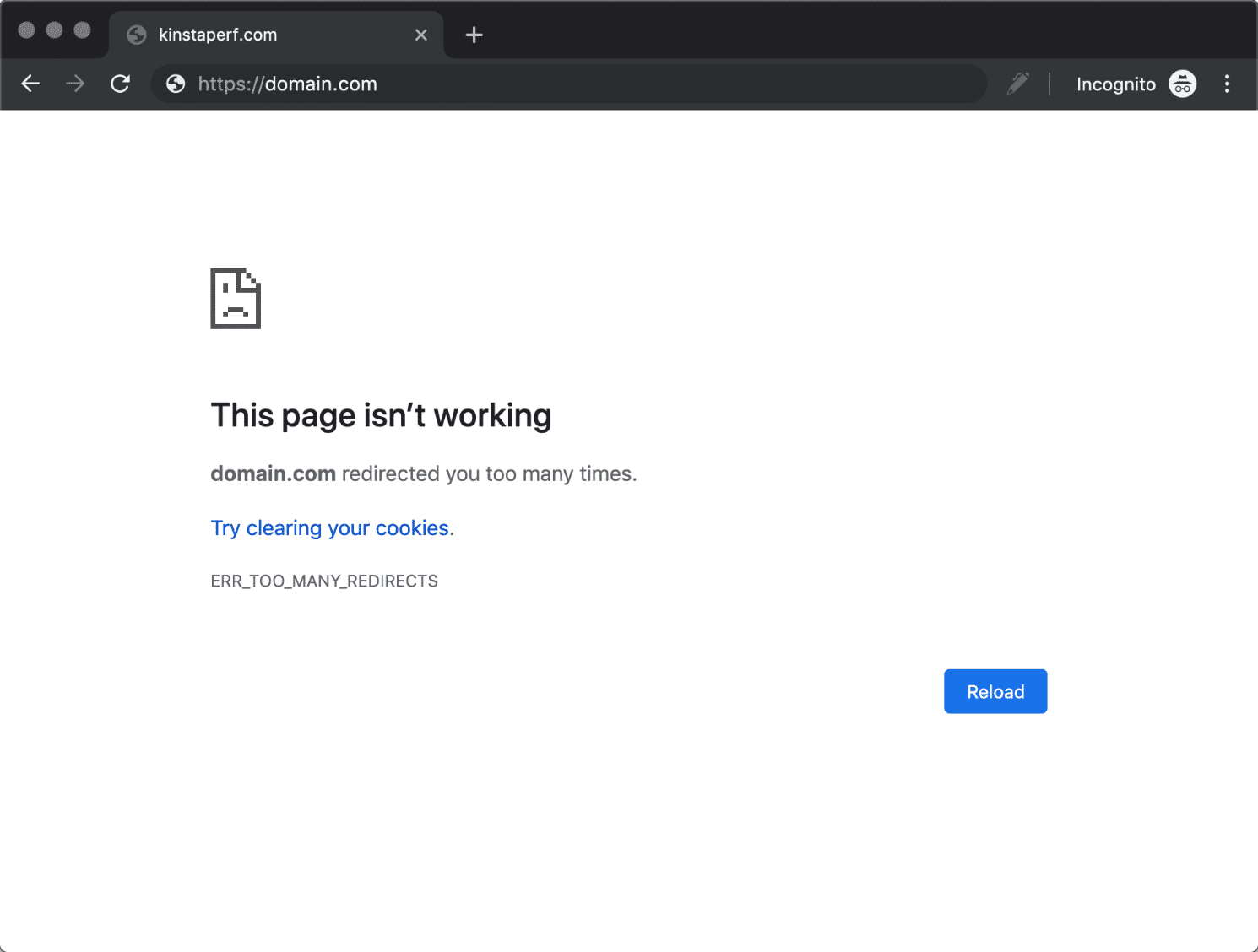
(Check out how to set Chrome's ERR_CACHE_MISS error).
Mozilla Firefox
In Mozilla Firefox information technology will show equallyThe folio isn't redirecting properly (as seen beneath).
An fault occured during a connection to domain.com. This trouble can sometimes be caused by disabling or refusing to accept cookies.
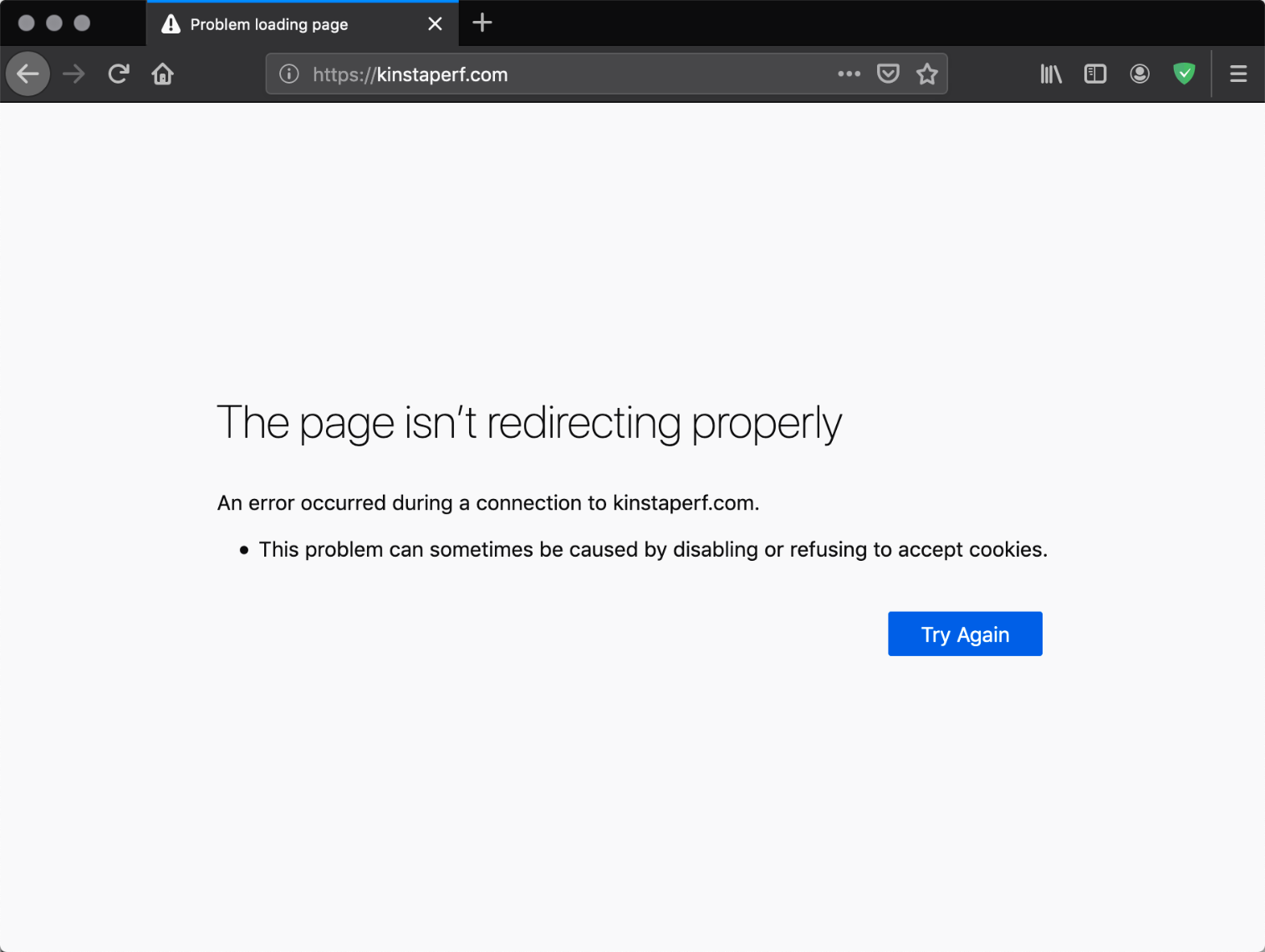
Microsoft Edge
In Microsoft Border, information technology will simply prove asThis page isn't working right now (every bit seen beneath).
Domain.com redirected y'all too many times.
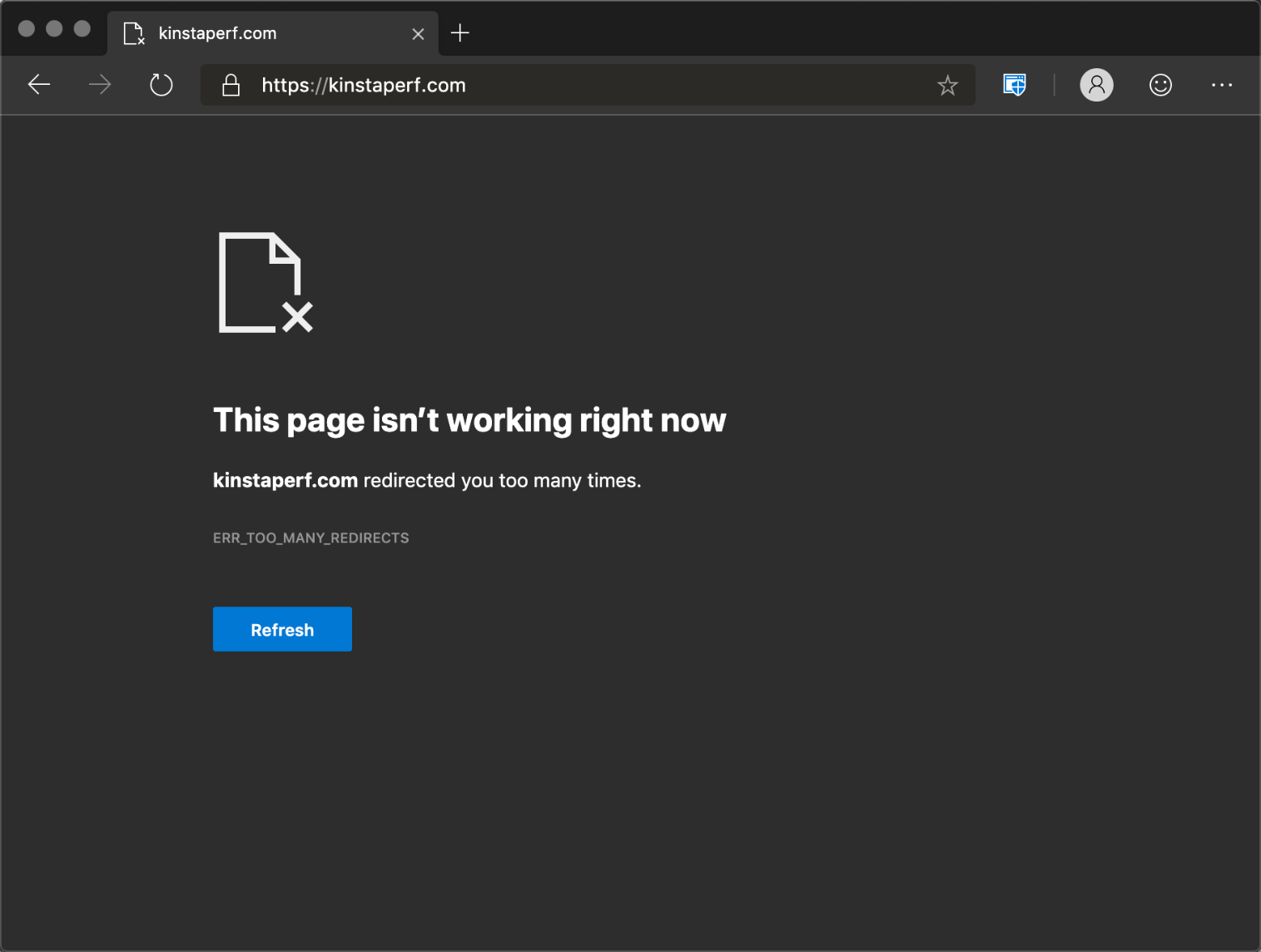
Safari
In Safari, it will show as Safari Can't Open the Page (equally seen below).
Too many redirects occurred trying to open "domain.com." This might occur if you open up a page that is redirected to open another page which is and so redirected to open the original page.

Hither are some recommendations and things to cheque to set up the mistake (sorted in order by well-nigh common reasons we come across):
- Delete cookies on that specific site
- Clear WordPress site, server, proxy, and browser cache
- Determine nature of redirect loop
- Cheque your HTTPS settings
- Check third-political party services
- Check your WordPress site settings
- Temporarily disable WordPress plugins
- Check redirects on your server
Delete Cookies on That Specific Site
Google and Mozilla both in fact recommend right below the error to "effort clearing your cookies." Cookies tin can sometimes contain faulty data in which could cause the ERR_TOO_MANY_REDIRECTS error. This is one recommendation you can try even if you're encountering the mistake on a site you don't own.
Due to the fact that cookies retain your "logged in" status on sites and other settings, nosotros recommend simply deleting the cookie(s) on the site that is having the problem. This way y'all won't impact whatever of your other sessions or websites that you frequently visit.
Follow the steps below to delete a cookie on a specific website in Google Chrome.
Step 1
In Google Chrome click on the three small-scale dots in the upper right-hand corner. Then click on "Settings."
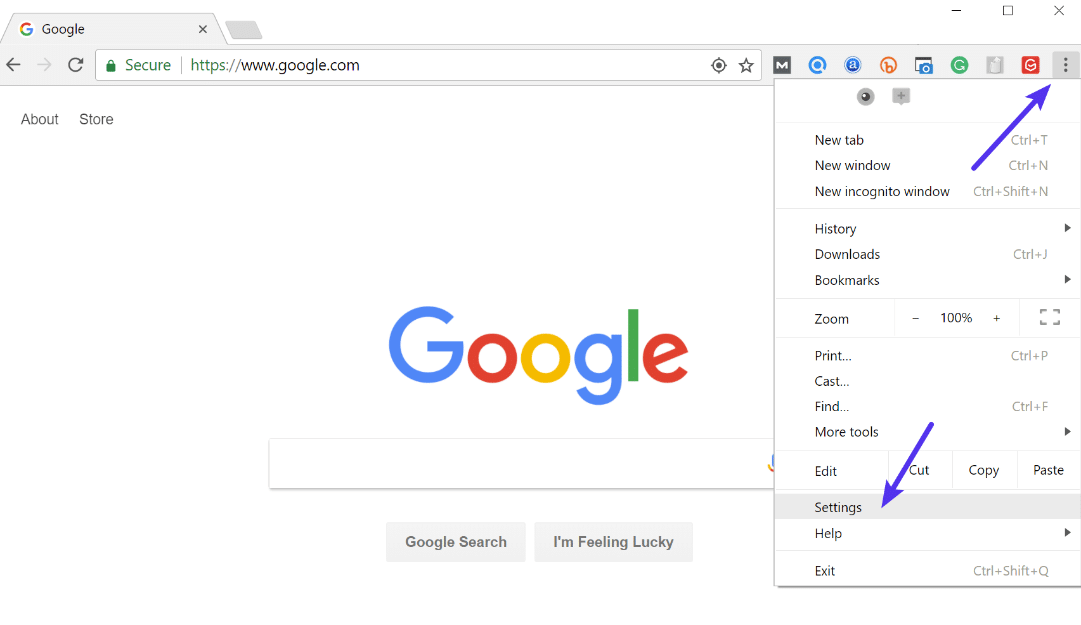
Stride two
Scroll down and click on "Advanced."
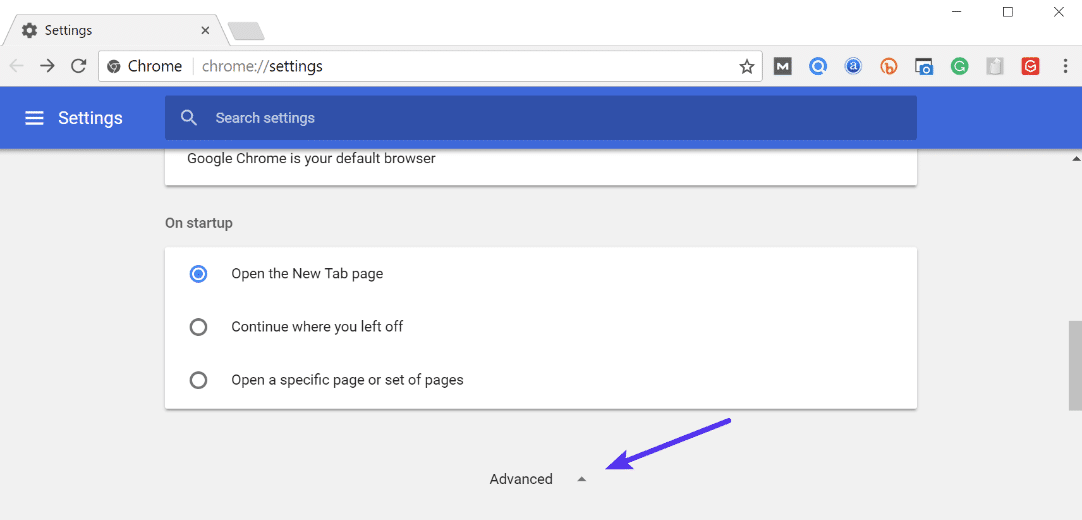
Step 3
Then click on "Content settings."
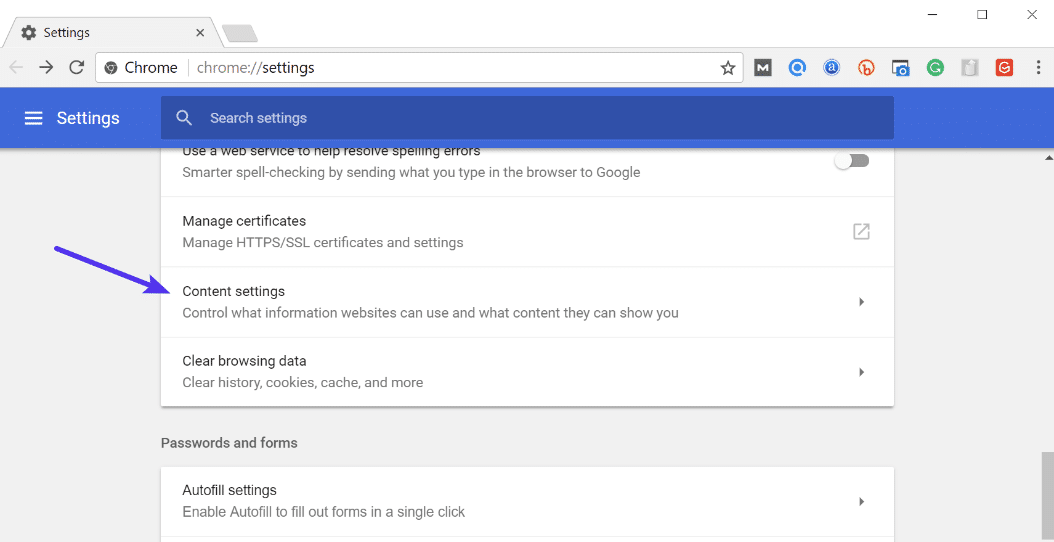
Step 4
Click on "Cookies."
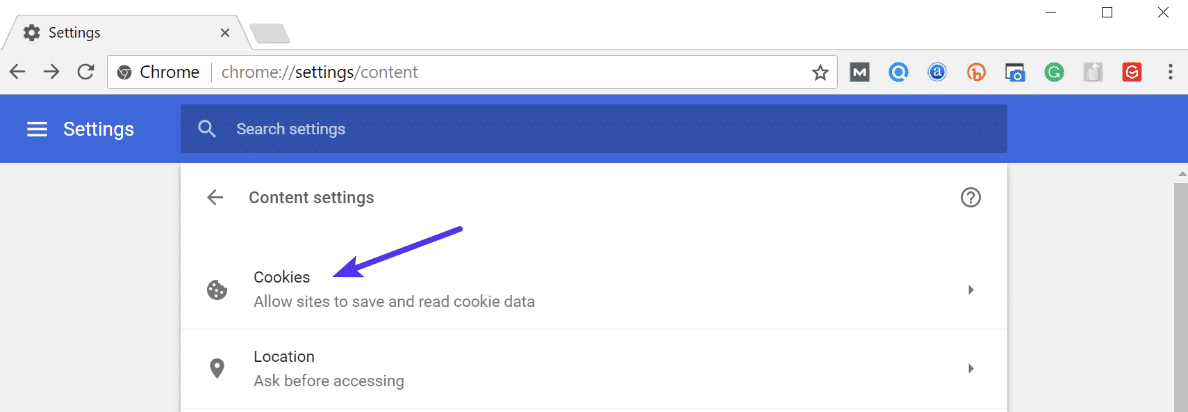
Step five
And then click on "See all cookies and site data."
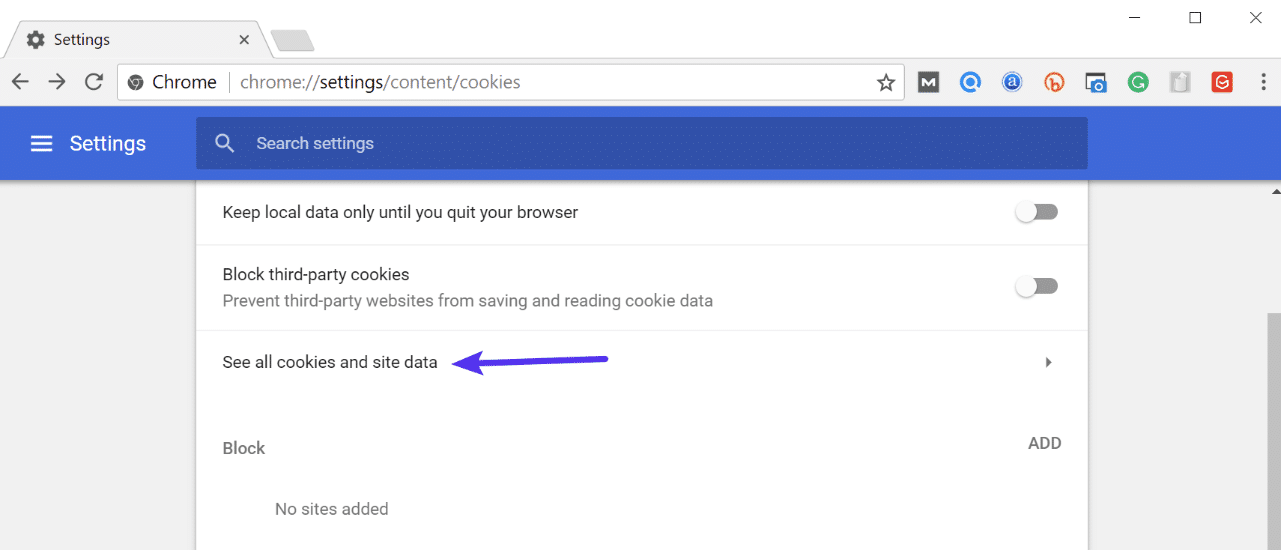
Step 6
Search for the site (domain) where you are encountering the ERR_TOO_MANY_REDIRECTS mistake. You can and then delete the cookie(s) currently stored on your computer for that domain. And then try visiting the site again.
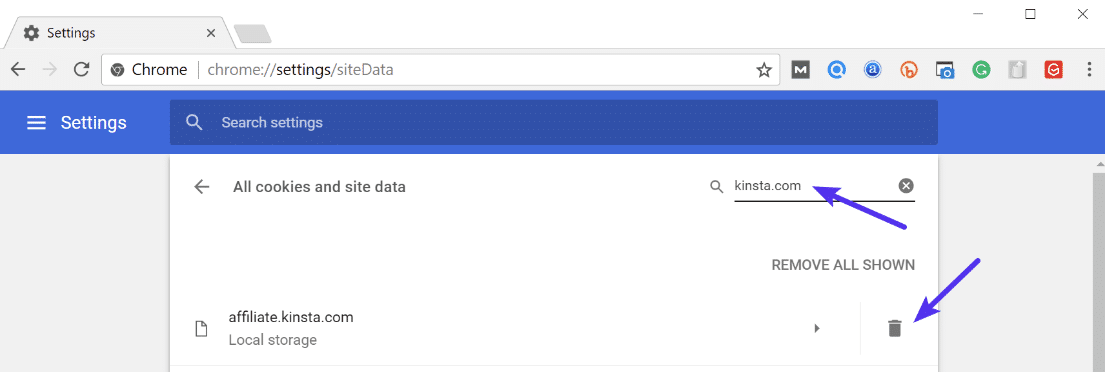
Clear Server, Proxy, and Browser Cache
Due to the fact that redirect loops are responses that tin can be cached, it'due south always recommended to endeavor clearing the enshroud on your WordPress site, the server, third-party proxy services, and even your browser if necessary.
Subscribe At present
Articulate WordPress Site Cache
Depending upon the type of redirect loop, you might all the same be able to gain access to your WordPress admin dashboard. In this case, you tin can easily clear the cache within the settings of your caching plugin. Here are a couple of quick links on how to clear WordPress cache with popular plugins:
- Clear Cache with Cache Enabler
- Clear Cache with W3 Total Cache
- Clear Cache with Super Cache
If y'all're a Kinsta client, y'all tin hands clear your cache from the WordPress admin toolbar.
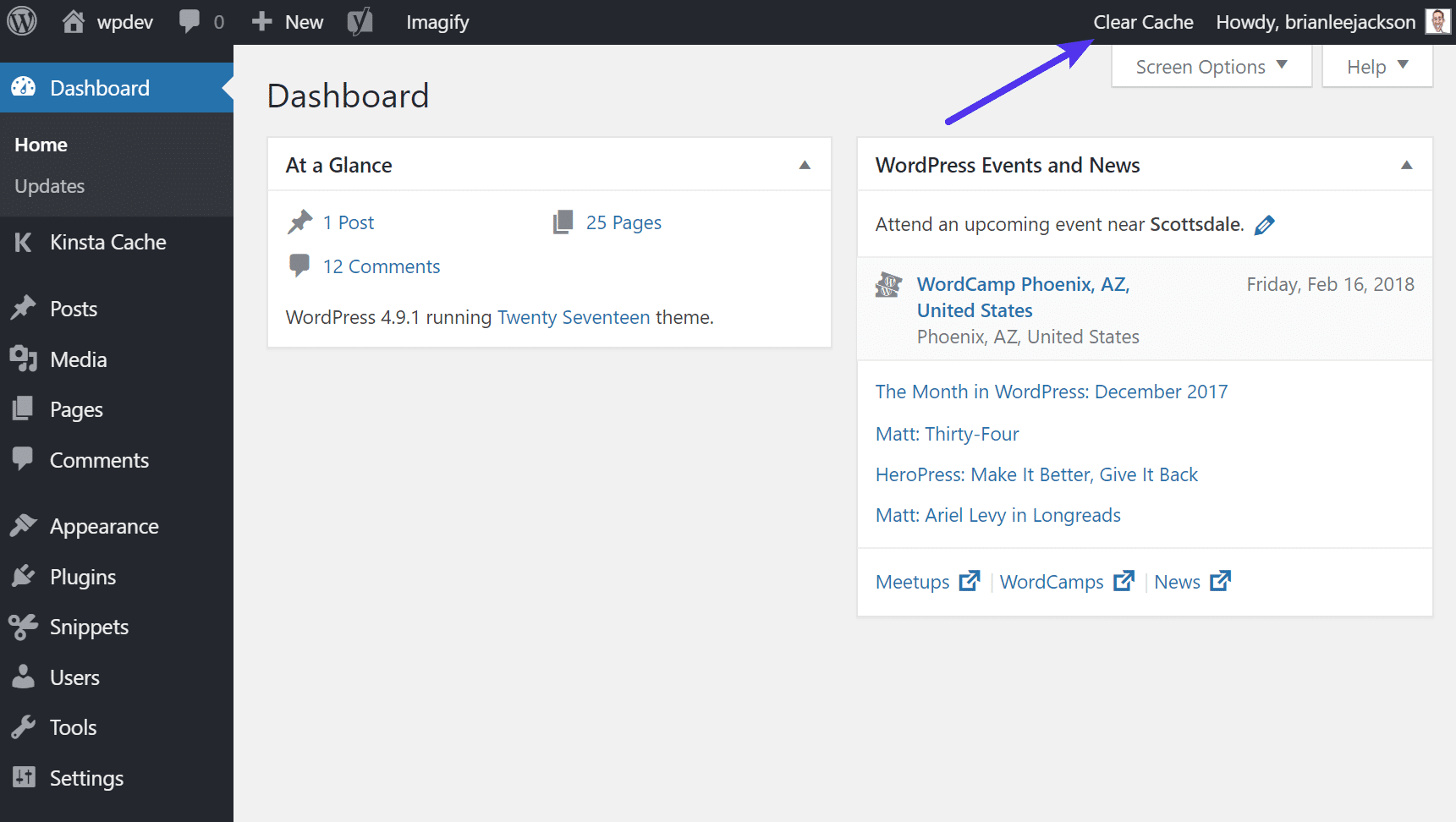
Articulate Server Cache
If you tin can't admission WordPress admin, many WordPress hosts have their own control panel tools for clearing the enshroud on your WordPress site.
If you're a Kinsta customer, you lot can manually articulate WordPress cache from within the MyKinsta dashboard. Simply click on your site, click into tools, and click on the "Clear Cache" push button. And then check your site to see if the redirect loop still exists.
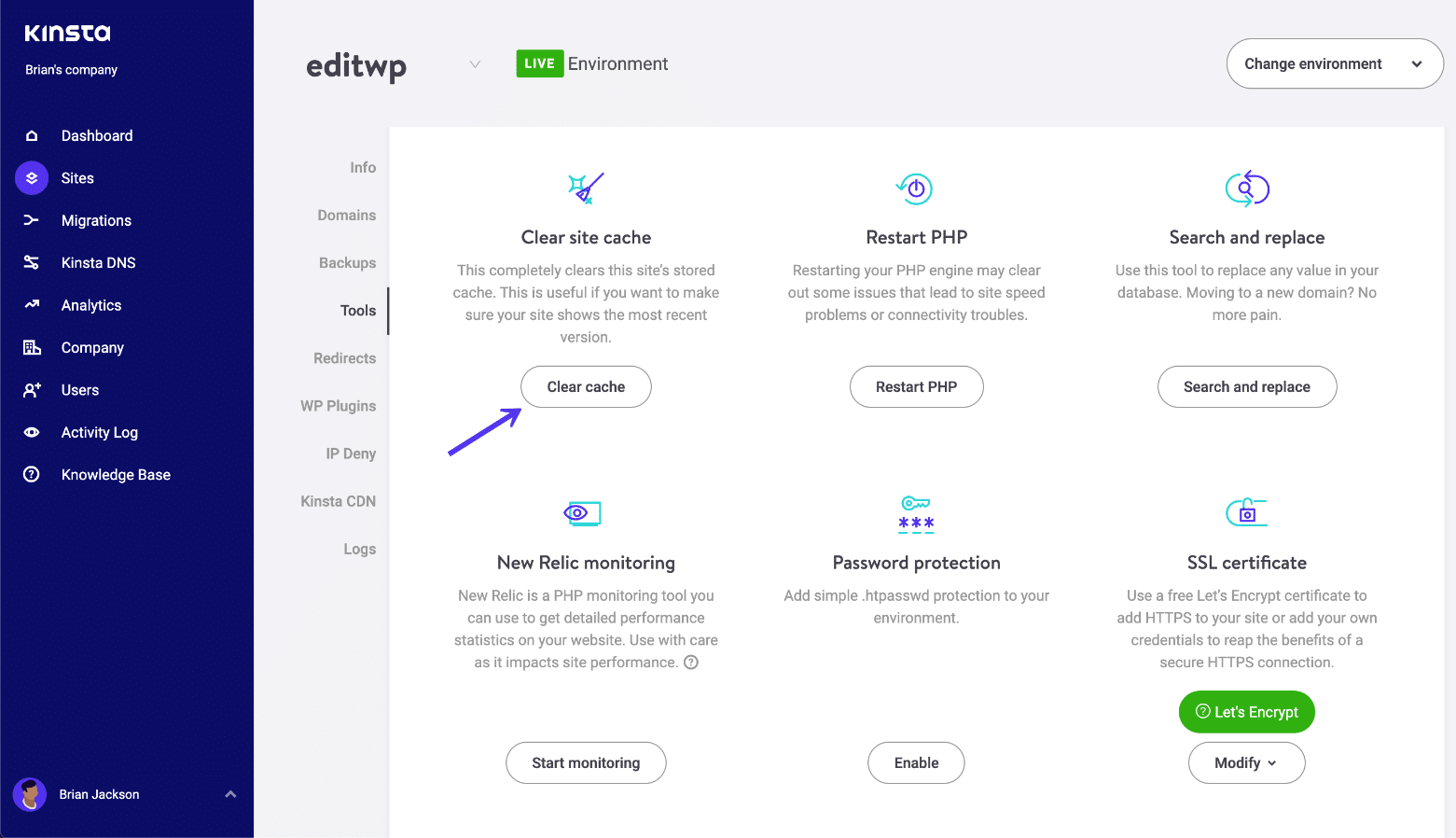
Clear Proxy Enshroud
If you're using a third-political party reverse-proxy service such equally Cloudflare or Sucuri, information technology can too be beneficial to clear the enshroud on their side.
Cloudflare
To purge Cloudflare cache, login to their dashboard, click into "Caching" and click on "Purge Everything."
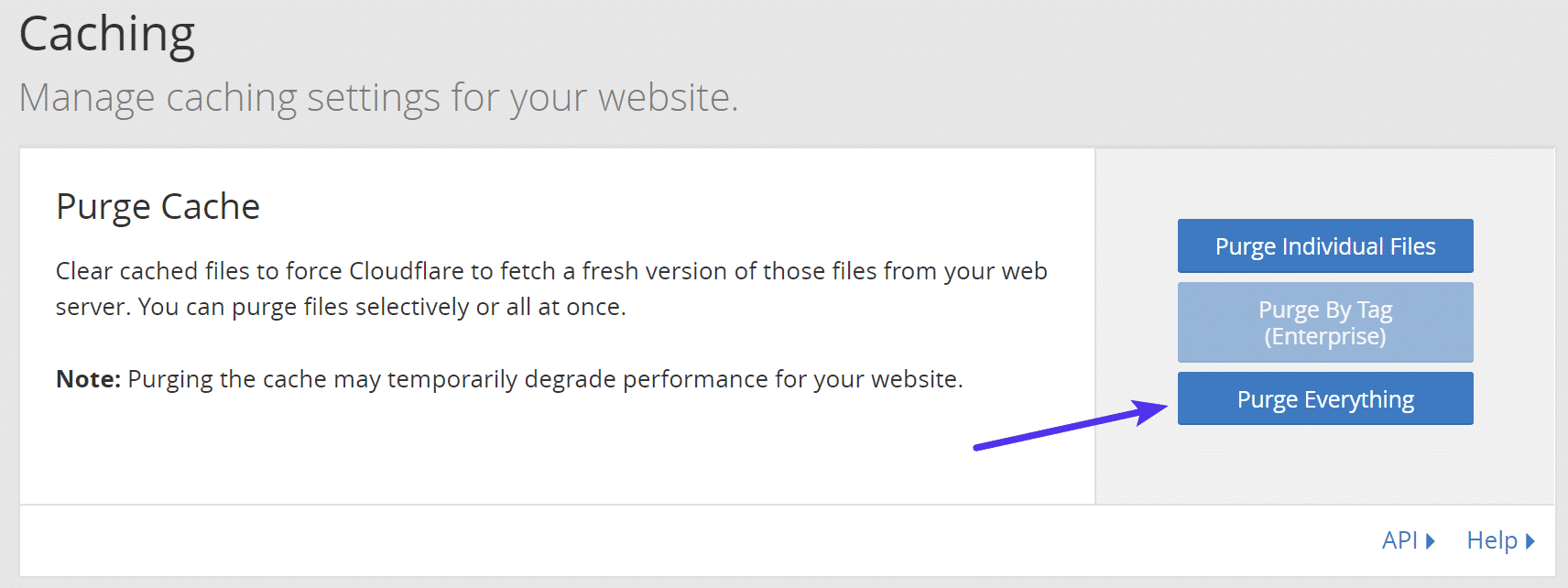
Sucuri
To purge Sucuri cache, login to their dashboard, go to "Performance" and click on "Articulate Cache."
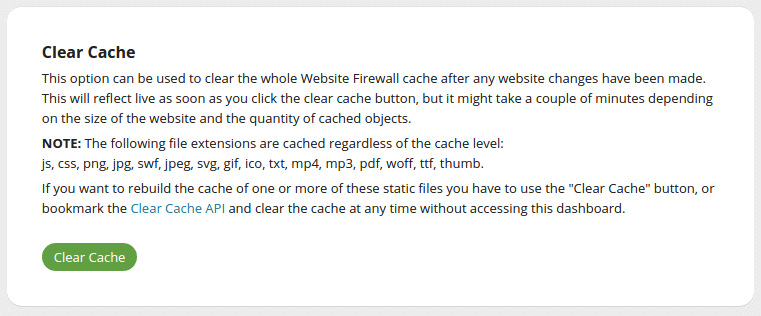
Articulate Browser Enshroud
If you want to check and meet if it might be your browser enshroud, without clearing your enshroud, you can ever open upward your browser in incognito mode. Or test another browser and come across if you lot still see the ERR_TOO_MANY_REDIRECTS error.
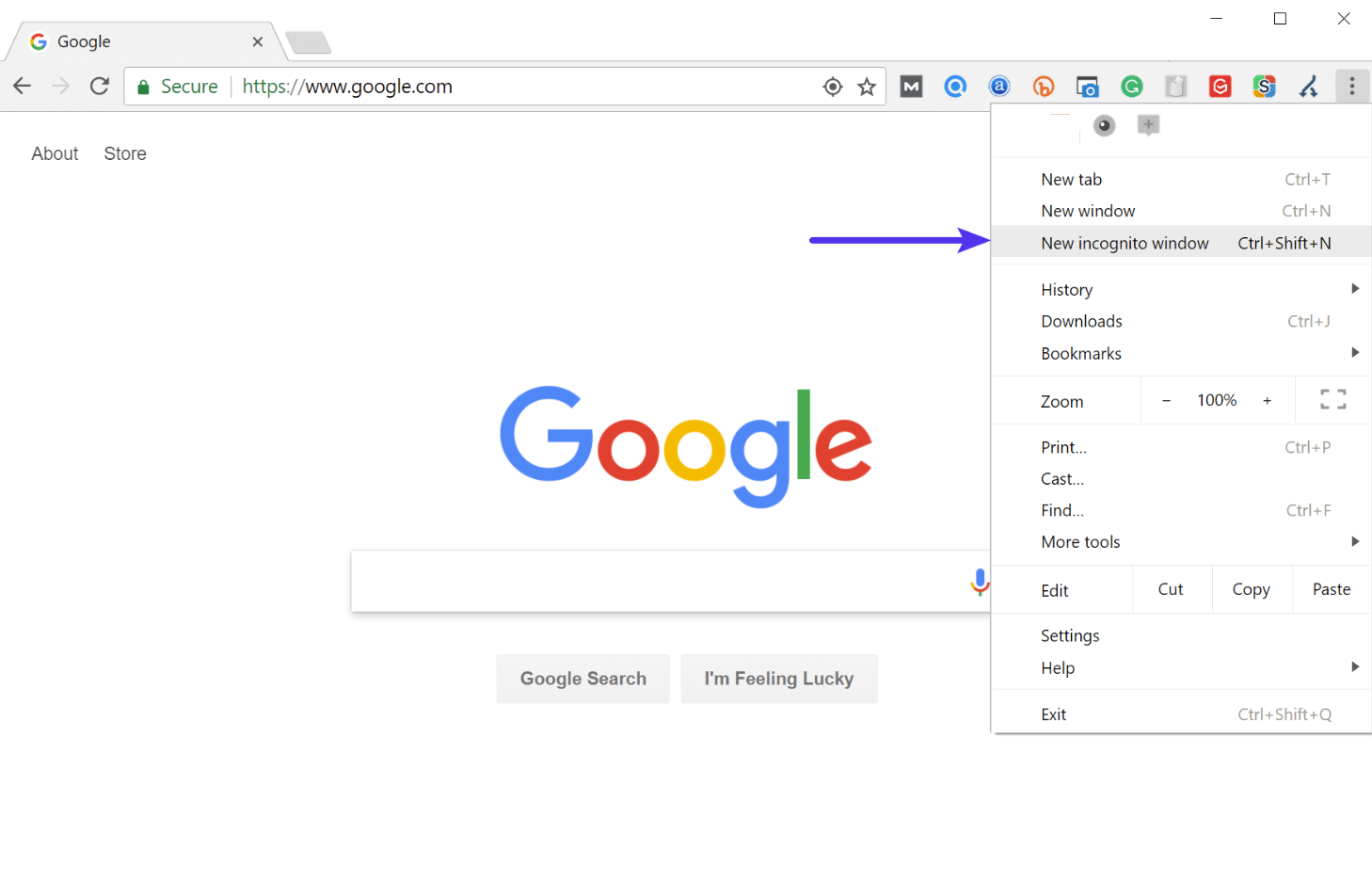
If you determine information technology is being caused by your browser enshroud, you lot tin and then articulate it. Below are instructions on how to do it in various browsers:
- How to Force Refresh a Unmarried Page for All Browsers
- How to Clear Browser Cache for Google Chrome
- How to Clear Browser Cache for Mozilla Firefox
- How to Clear Browser Enshroud for Safari
- How to Clear Browser Cache for Net Explorer
- How to Clear Browser Cache for Microsoft Edge
- How to Clear Browser Enshroud for Opera
Determine Nature of Redirect Loop
If immigration the cache didn't work, then you'll want to come across if you lot can determine the nature of the redirect loop. Our gratis online Redirect Checker tool can assistance provide some farther analysis into what might be going on. This could also be done via curlicue.
For example, on the site below, it has a 301 redirect loop back to itself, which is causing a large chain of faulty redirects. Yous can follow all the redirects and determine whether or not it's looping back to itself, or peradventure is an HTTP to HTTPS loop in which we'll hash out how to solve that further beneath.
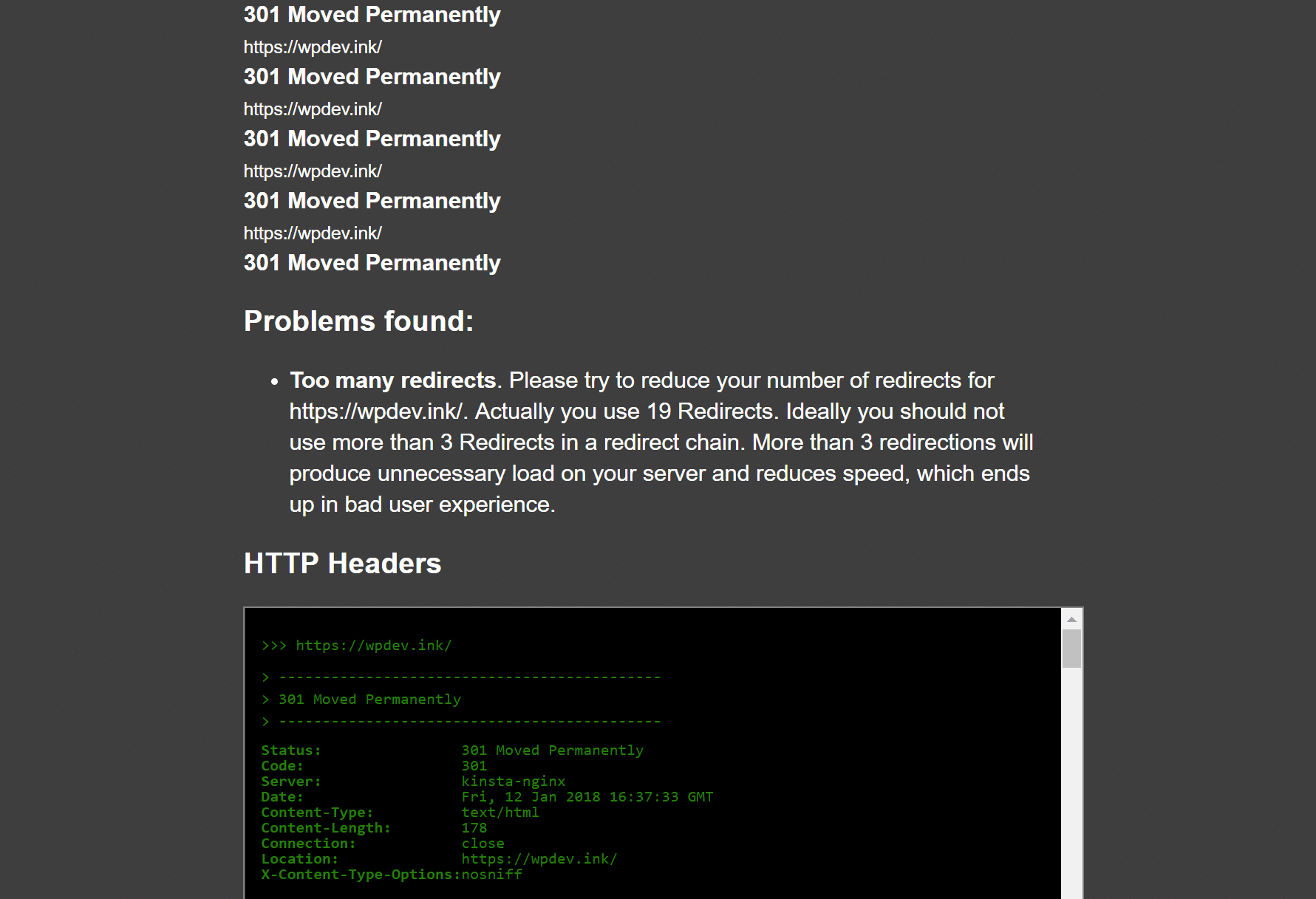
The Redirect Path Chrome extension can likewise be very useful and provides insights into all of the redirects happening on your site (specific URL or page.
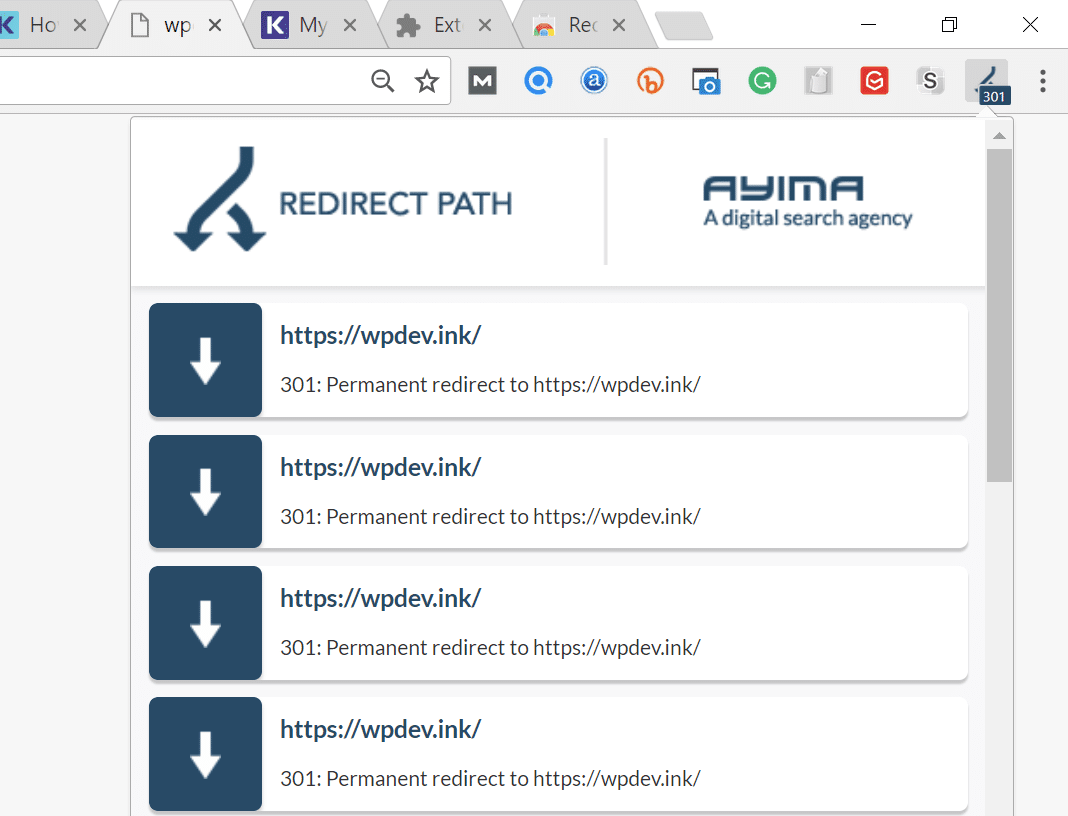
Bank check Your HTTPS Settings
Another thing to check is your HTTPS settings. A lot of times we 've seen ERR_TOO_MANY_REDIRECTS occur when someone has simply migrated their WordPress site to HTTPS and either didn't finish or set up something incorrectly.
1. Don't Force HTTPS Without an SSL Certificate
This is by far the most common reason we see on a regular basis. If you lot force your WordPress site to load over HTTPS without commencement installing an SSL certificate, you'll instantly throw your site into a redirection loop. To set this, simply install an SSL certificate on your WordPress site.
It's as well recommended to run an SSL cheque. SSL/TLS certificates require not only your main certificate but besides what they phone call intermediate certificates (chain) to also be installed. These demand to be set up properly.
We recommend using the free SSL bank check tool from Qualys SSL Labs. Information technology is very reliable and we use it for all Kinsta clients when verifying certificates. Only head over to their SSL check tool, input your domain into the Hostname field and click on "Submit." You can also select the choice to hide public results if you lot prefer. Information technology could take a infinitesimal or two to scan your site'southward SSL/TLS configuration on your web server.
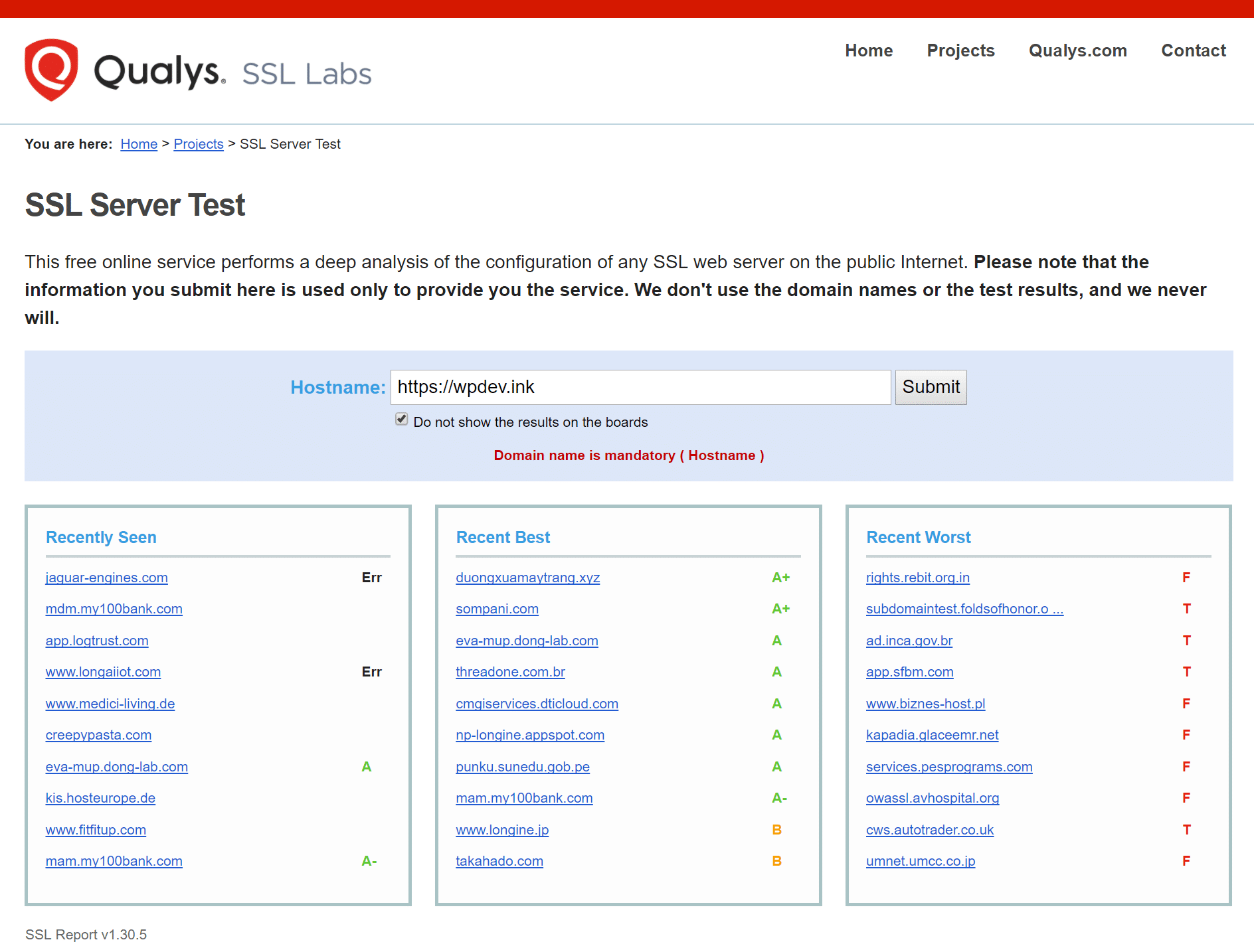
2. Don't Use an SSL Plugin, Update your Hard-coded Links
In that location are some complimentary SSL WordPress plugins, such every bit the Really Simple SSL plugin that will help you automatically redirect to HTTPS. Withal, nosotros don't recommend this method as a permanent solution because 3rd-party plugins can always innovate another layer of problems and compatibility problems. It'south a good temporary solution, but you should really update your hard-coded HTTP links.
We have a great tutorial with 4 easy ways to do a search and supervene upon in WordPress. If you're a Kinsta client, you can always reach out to our back up team to do this for you as well.
three. Cheque HTTP to HTTPS Redirects on Server
Information technology could very well be that possibly the HTTPS redirect rules on your server were misconfigured.
Redirect HTTP to HTTPS in Nginx
If your spider web server is running Nginx, you lot can hands redirect all of your HTTP traffic to HTTPS by adding the following code to your Nginx config file. This is the recommended method for redirecting WordPress running on Nginx.
server { listen 80; server_name domain.com www.domain.com; return 301 https://domain.com$request_uri; } Nosotros use Nginx for everyone here at Kinsta. The corking news is that you don't have to worry virtually this. If you need to add together a redirect simply open up a quick support ticket and let united states of america know which domain you need to be redirected. We and then add together it to the Nginx config for yous.
Bank check Out Our Video Guide to Redirects
Redirect HTTP to HTTPS in Apache
If your web server is running Apache, yous can easily redirect all of your HTTP traffic to HTTPS past adding the following code to your.htaccess file. This is the recommended method for redirecting WordPress running on Apache.
RewriteEngine On RewriteCond % { HTTPS } off RewriteRule ^ ( . * )$ https: //%{HTTP_HOST}%{REQUEST_URI} [L,R=301] iv. Cheque For Too Many HTTPS Redirects
Maybe you merely take besides many HTTPS redirects. You can easily cheque your site to see how many redirects it's using with Patrick Sexton'due south Redirect mapper tool. Hither is an example below of redirects that are not gear up up correctly which are easily spottable using the redirect mapper. You can meet that there are duplicate HTTPS redirects happening on both the www and non-www versions.
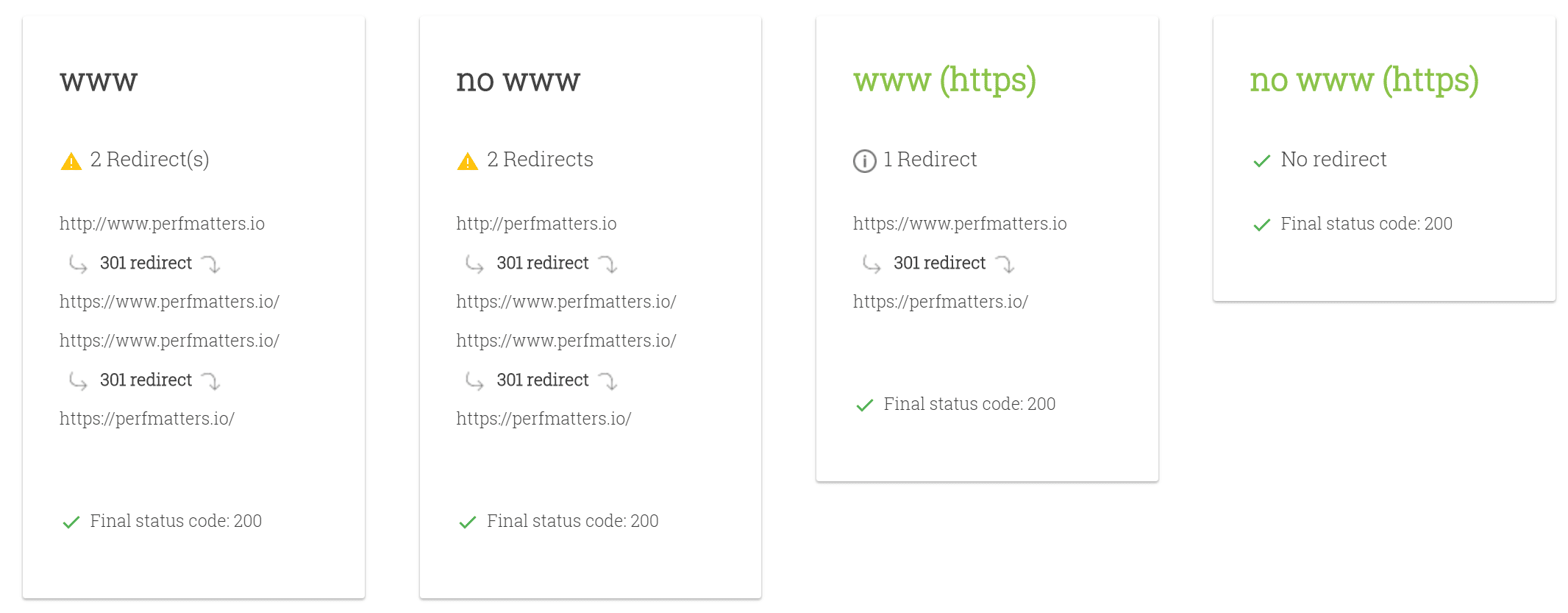
Bank check Third-Party Services
ERR_TOO_MANY_REDIRECTS is also frequently commonly acquired past opposite-proxy services such as Cloudflare. This usually happens when their Flexible SSL option is enabled and you already have an SSL certificate installed with your WordPress host. Why? Because, when flexible is selected, all requests to your hosting server are sent over HTTP. Your host server well-nigh likely already has a redirect in identify from HTTP to HTTPS, and therefore a redirect loop occurs.
To set this you need to change the Cloudflare Crypto settings from Flexible to either Full or Full (strict). If y'all're a Kinsta client, brand sure to also bank check out our steps on how to install an SSL certificate while using Cloudflare.
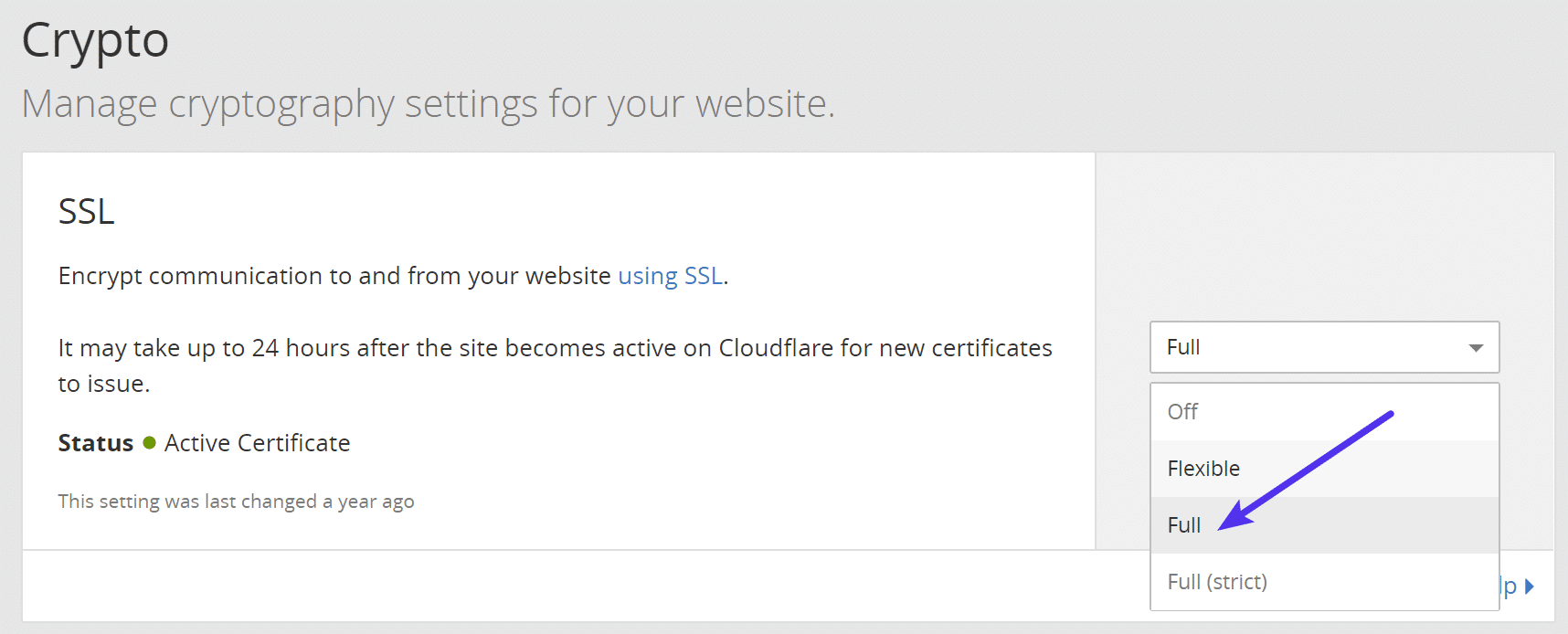
You can utilize their Always Use HTTPS page rule to redirect all users to HTTPS without creating a loop. Another thing to lookout out for with Cloudflare is their forwarding URL redirection rules. Exist careful not to create a redirect where the domain points to itself as a destination. This can cause an space redirect mistake, and the affected URLs volition not be able to resolve.
If y'all're using StackPath, they have an option chosen "Origin Pull Protocol" that needs to be prepare to HTTPS only.
Using Cloudflare DNS Just
If you simply want to use Cloudflare'southward DNS, and not their proxy/WAF service, and so yous should brand sure your DNS records are fix to "DNS Merely." The clouds will announced as "grey" instead of "orange." You lot configure this under the "DNS" tab in the Cloudflare control panel.

Check Your WordPress Site Settings
Another thing to cheque is your WordPress site settings. There are two dissimilar fields you'll want to ensure are set correctly, and not pointing at a wrong domain or are mismatched. Another common fault is that you're not using the correct prefix to match the rest of your site, www or non-www. Sometimes people migrate hosts, or modify domains and these can get changed without y'all realizing information technology.
- WordPress Address (URL): The accost to reach your blog.
- Site Address (URL): The address of your WordPress core files.
Both should match unless you are giving WordPress it's own directory.
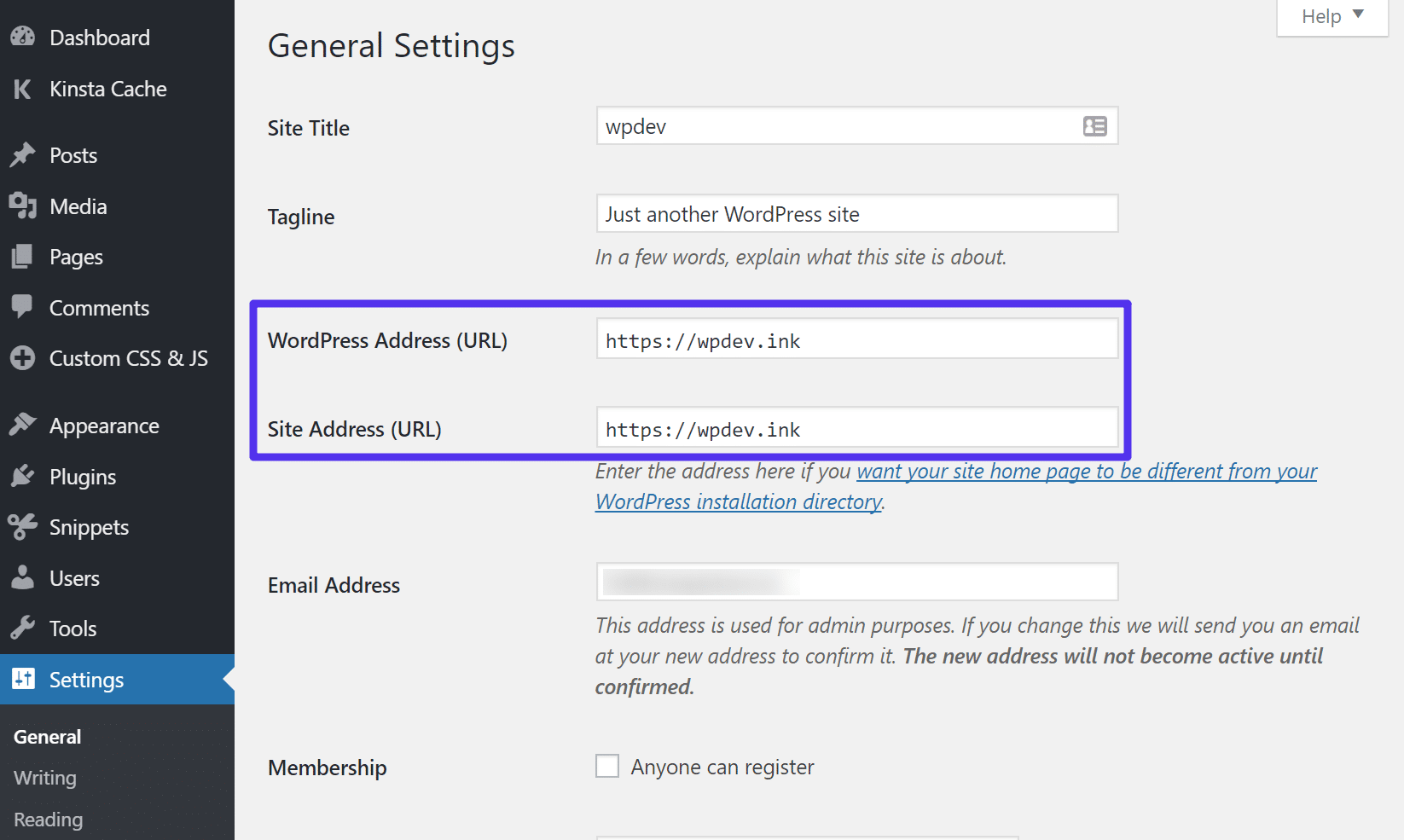
Most probable though you aren't able to access your WordPress dashboard. And then what you tin can do is override the settings above by inputting the values in your wp-config.php file.
The wp-config.php file is typically located at the root of your WordPress site and tin can be accessed via FTP, SSH, or WP-CLI. To hard-lawmaking WP_HOME and WP_SITEURL, simply input the post-obit code towards the top of the file, changing the values to reverberate your domain.
define('WP_HOME','https://yourdomain.com'); ascertain('WP_SITEURL','https://yourdomain.com'); Below is an example of what your wp-config.php file might look like afterwards.

Or if you prefer, here are two additional means y'all could change your WordPress URLs without access to your admin dashboard:
- Change WordPress URL Directly in Database
- Change WordPress URL With WP-CLI
In one case you lot manually set it, you can browse to your site to verify whether or not it fixes the redirect loop.
Multisite
If you're changing domains on a multisite, make sure to also check the wp_blogs table. Nosotros've seen people practise a search and supplant wrong and cause an infinite redirect loop. This is because the network site doesn't match the subsites.
wp_#_options: Each subsite will have sets of tables that represent to theblog_id in thewp_blogs tabular array. Go to thewp_#_options table, where # corresponds to theblog_id, and update the "SITEURL" and "Dwelling" settings in that table.
Temporarily Disable WordPress Plugins
When it comes to WordPress, temporarily disabling all your WordPress plugins tin be a quick style to spot problems. For example, plugins such equally Redirection or Yoast SEO premium let you implement redirects. Sometimes settings or updates to these plugins can conflict with redirects that might already be fix on your server, causing a redirect loop.
Think, you won't lose any data if you simply disable a plugin. Most likely you tin can't access the WordPress admin, and then you'll demand login via SFTP to your server and rename your plugins folder to something like plugins_old. Then check your site again.

If it works, and so you will need to test each plugin one by one. Rename your plugin folder dorsum to "plugins" and then rename each plugin folder within of if it, one by one, until you find it. You could also try to replicate this on a staging site starting time.
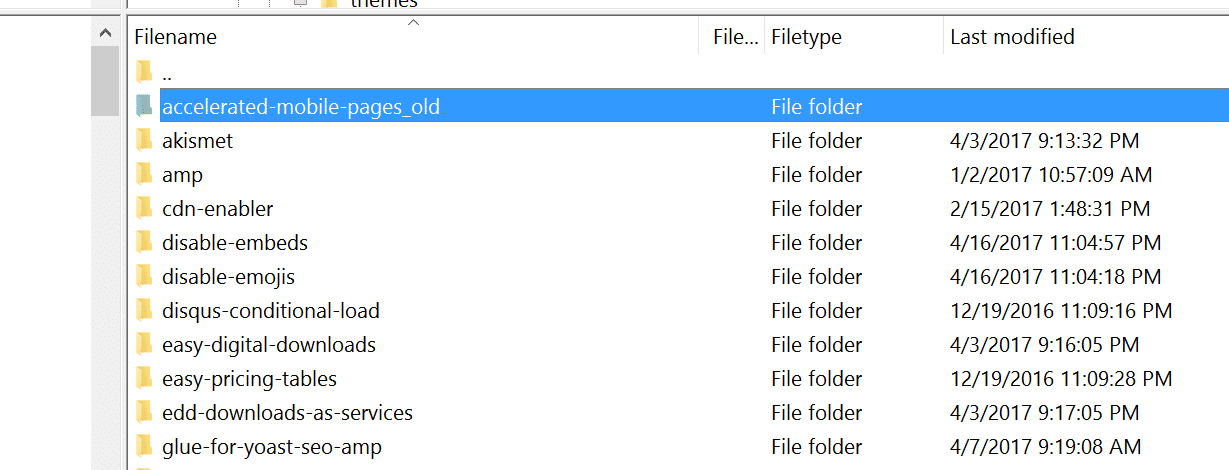
Check Redirects on Your Server
As well HTTP to HTTPS redirects on your server, it can be good to cheque and make certain in that location aren't any additional redirects setup wrong. For example, i bad 301 redirect dorsum to itself could accept down your site. Usually, these are plant in your server's config files.
Apache .htaccess file
Kinsta but uses Nginx, but if you're using a WordPress host that is running Apache, it could very well exist that your.htaccess file has a wrong rule in information technology. Follow the steps below to recreate a new one from scratch.
Commencement, login to your site via FTP or SSH, and rename your.htaccess file to.htaccess_old. This ensures y'all take a backup.
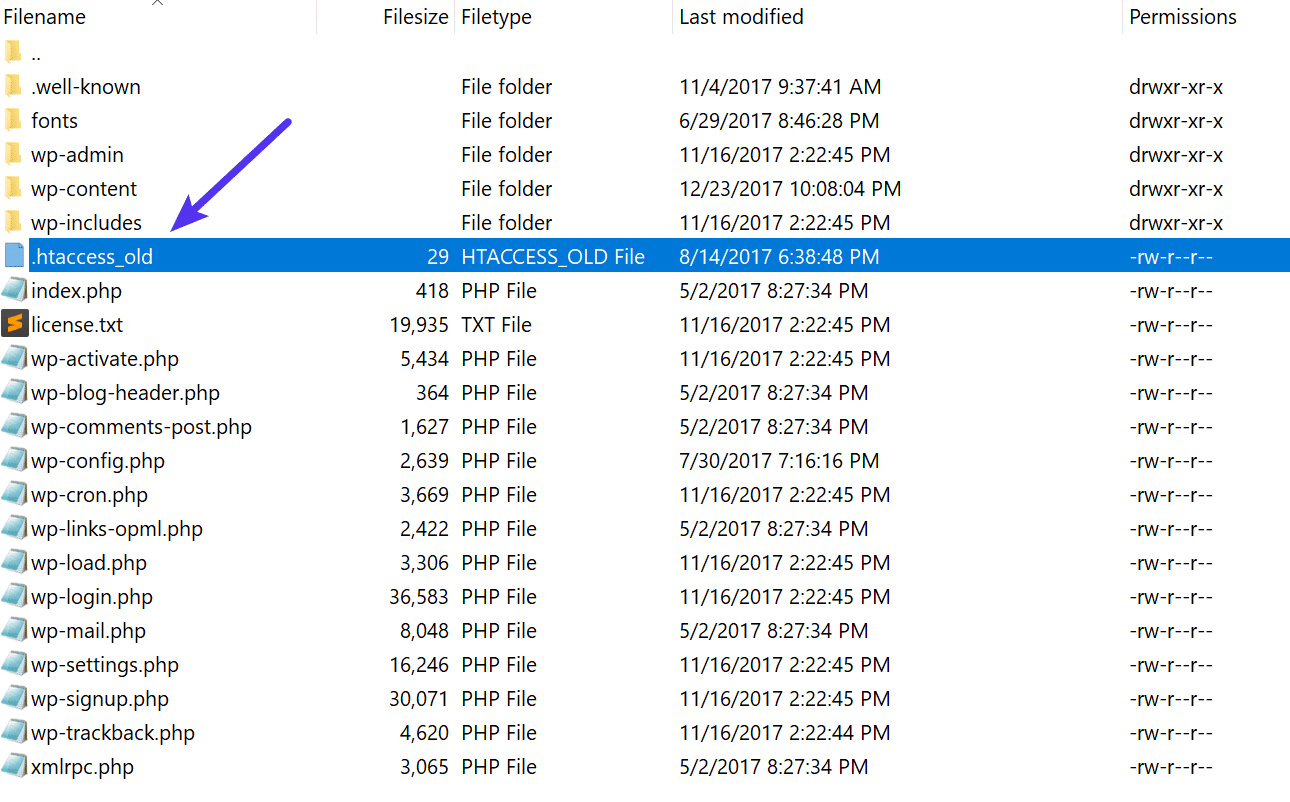
Ordinarily to recreate this file you can merely re-salve your permalinks in WordPress. However, if you're in the middle of an ERR_TOO_MANY_REDIRECTS fault you lot nigh probable can't access your WordPress admin, so this isn't an option. Therefore you can create a new.htaccess file and input the following contents. And so upload it to your server. The following uses the default settings.
# BEGIN WordPress <IfModule mod_rewrite.c> RewriteEngine On RewriteBase / RewriteRule ^index\.php$ - [L] RewriteCond %{REQUEST_FILENAME} !-f RewriteCond %{REQUEST_FILENAME} !-d RewriteRule . /alphabetize.php [50] </IfModule> # Cease WordPress See the WordPress Codex for more than examples, such as a default.htaccess file for multisite.
We've taken our cognition of effective website management at calibration, and turned information technology into an ebook and video course. Click hither to download the The 2020 Guide to Managing 40+ WordPress Sites!
Nginx Config
If your host uses Nginx, this file tin can be a little trickier every bit the config file can vary a bit depending on the hosting provider. Nosotros recommend reaching out to your host and have them bank check your config file for annihilation that might be causing a redirect loop or besides many redirects.
If you're a Kinsta client, y'all'll first want to check to ensure y'all didn't fix a redirect wrong in our redirect tool. Below is a simple instance of a redirect from https://domain.com/ back to itself, that would cause a redirect loop.
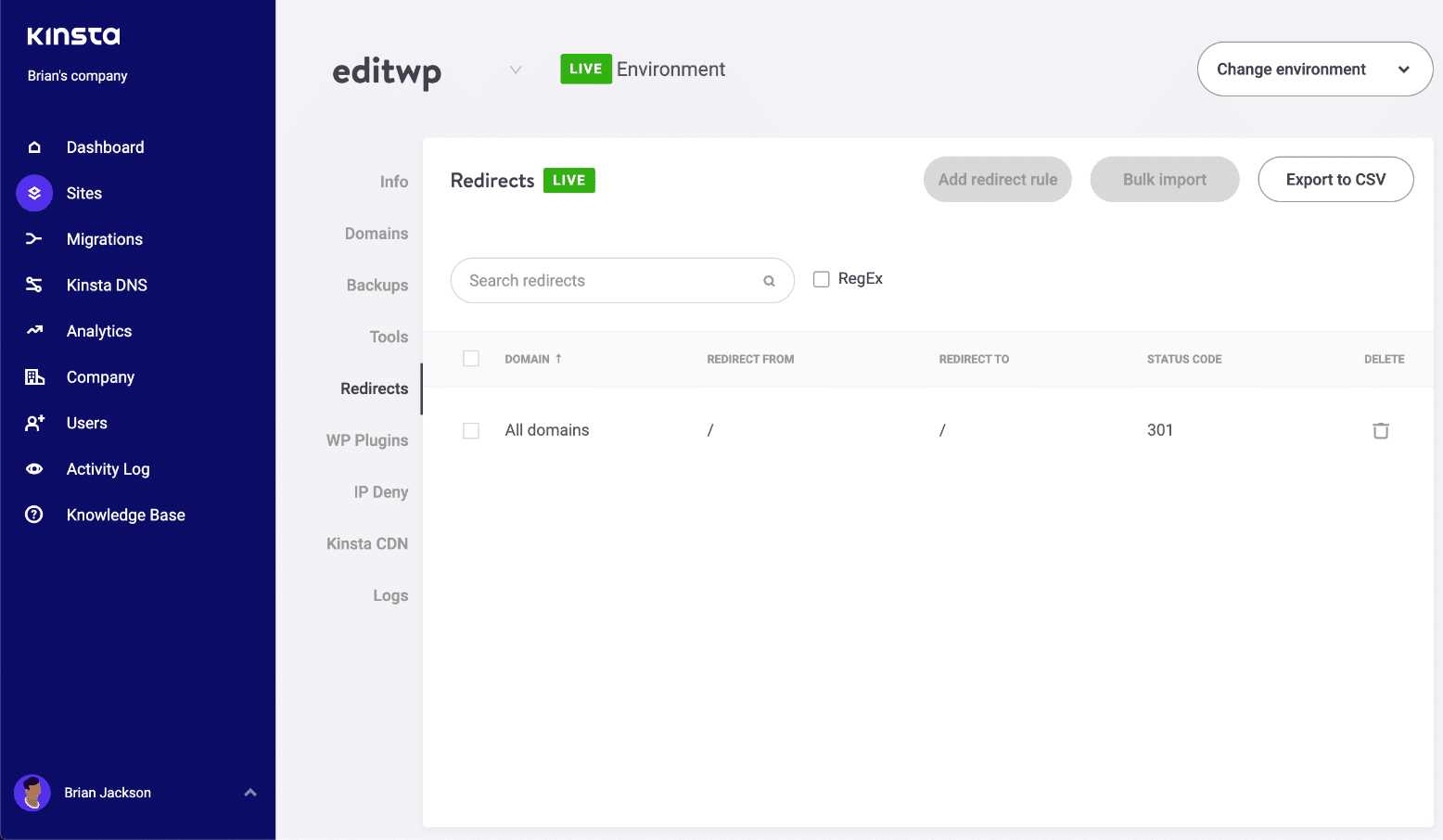
This besides commonly happens when the location URL is included in both "Redirect From" and "Redirection To."
For case, the following would cause a redirect loop:
Redirect From:^/blog/nighRedirect To:https://domain.com/blog/most-me
Why? Because once the procedure reached^/blog/most, the remaining part-me wouldn't thing, and it would cause an infinite loop. You accept to specify the end of the string and the starter bespeak. Here is what y'all would practice to fix it:
Redirect From:^/weblog/about$Redirect To:https://domain.com/blog/about-me
The $ character will tell Nginx to terminate and match the request just if the string is in that location exactly, simply nothing after it.
And of form, you lot can always open up up a support ticket and nosotros'll check this for you.
Misconfigured Reverse Proxies
Some other common reason for the ERR_TOO_MANY_REDIRECTS error is if you are using a reverse proxy. Reverse proxies tin be quite complicated and it's very easy to ship your WordPress site into a redirect loop if misconfigured. Again, if you're a Kinsta client, our support team can help with this.
Summary
Redirect loops tin can sometimes be tricky to track down. But hopefully, some of the troubleshooting steps above help you to resolve your ERR_TOO_MANY_REDIRECTS error. If we missed anything, feel gratis to let u.s.a. know below in the comments.
Salve fourth dimension, costs and maximize site performance with:
- Instant help from WordPress hosting experts, 24/7.
- Cloudflare Enterprise integration.
- Global audience reach with 32 data centers worldwide.
- Optimization with our built-in Application Operation Monitoring.
All of that and much more, in one plan with no long-term contracts, assisted migrations, and a 30-solar day-coin-back-guarantee. Bank check out our plans or talk to sales to find the plan that's right for y'all.
muncietuptionvill.blogspot.com
Source: https://kinsta.com/blog/err_too_many_redirects/
0 Response to "I Want to Open a Page but It Redirects Me to the Same Page Over Again"
Post a Comment